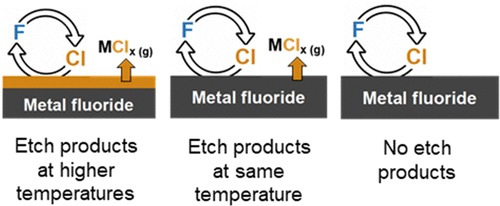当前位置:
X-MOL 学术
›
Chem. Mater.
›
论文详情
Our official English website, www.x-mol.net, welcomes your
feedback! (Note: you will need to create a separate account there.)
Spontaneous Etching of Metal Fluorides Using Ligand-Exchange Reactions: Landscape Revealed by Mass Spectrometry
Chemistry of Materials ( IF 7.2 ) Pub Date : 2021-09-21 , DOI: 10.1021/acs.chemmater.1c01950 Ann Lii-Rosales 1 , Andrew S. Cavanagh 1 , Andreas Fischer 2 , Thorsten Lill 2 , Steven M. George 1
Chemistry of Materials ( IF 7.2 ) Pub Date : 2021-09-21 , DOI: 10.1021/acs.chemmater.1c01950 Ann Lii-Rosales 1 , Andrew S. Cavanagh 1 , Andreas Fischer 2 , Thorsten Lill 2 , Steven M. George 1
Affiliation

|
Thermal atomic layer etching (ALE) can be performed using sequential reactions based on surface modification followed by volatile release of the modified surface layer. Surface modification can be accomplished using fluorination. Volatile release can then be achieved using precursors that undergo ligand-exchange reactions with the fluorinated surface layer. Metal fluorides can be employed to model the fluorinated surface layer. The ligand-exchange reaction between the precursor and the metal fluoride can lead to spontaneous etching of the metal fluoride. A new reactor with in situ quadrupole mass spectrometry (QMS) was constructed to observe the volatile etch products from the reaction of ligand-exchange precursors with metal fluoride powders. The metal fluoride powders were AlF3, HfF4, GaF3, InF3, and SnF4. The ligand-exchange precursors were Al(CH3)3, SiCl4, and TiCl4. A variety of studies were conducted including Al(CH3)3 + AlF3, SiCl4 + HfF4, SiCl4 + InF3, TiCl4 + SnF4, Al(CH3)3 + GaF3, and SiCl4 + AlF3. The temperature-dependent in situ QMS studies revealed the many possibilities that occur during the ligand-exchange reaction of precursors with metal fluoride powders. Various categories of behavior were observed from these studies: (i) Ligand exchange occurs at low temperature, but metal etch products from the substrate are not observed until high temperature. (ii) Ligand-exchange and metal etch products from the substrate are observed at similar temperatures. (iii) Ligand exchange occurs, but no metal etch products from the substrate are observed up to a limiting temperature. Knowledge of these possibilities for the ligand-exchange reaction between precursors and metal fluoride powders during spontaneous etching helps to further the understanding of thermal ALE.
中文翻译:

使用配体交换反应自发蚀刻金属氟化物:质谱揭示的景观
热原子层蚀刻 (ALE) 可以使用基于表面改性的顺序反应进行,然后改性表面层的挥发释放。可以使用氟化来完成表面改性。然后可以使用与氟化表面层发生配体交换反应的前体实现挥发性释放。金属氟化物可用于模拟氟化表面层。前体和金属氟化物之间的配体交换反应可导致金属氟化物的自发蚀刻。构建了具有原位四极杆质谱 (QMS)的新反应器,以观察配体交换前体与金属氟化物粉末反应的挥发性蚀刻产物。金属氟化物粉末为 AlF 3、HfF4、GaF 3、InF 3和SnF 4。配体交换前体是Al(CH 3 ) 3、SiCl 4和TiCl 4。进行了各种研究,包括 Al(CH 3 ) 3 + AlF 3、SiCl 4 + HfF 4、SiCl 4 + InF 3、TiCl 4 + SnF 4、Al(CH 3 ) 3 + GaF 3和 SiCl 4 + AlF 3 . 温度相关的原位QMS 研究揭示了在前体与金属氟化物粉末的配体交换反应过程中发生的许多可能性。从这些研究中观察到各种类型的行为:(i)配体交换发生在低温下,但直到高温才观察到来自基板的金属蚀刻产物。(ii) 在相似的温度下观察到来自基板的配体交换和金属蚀刻产物。(iii) 配体交换发生,但在极限温度下没有观察到来自基板的金属蚀刻产物。了解自发蚀刻过程中前体和金属氟化物粉末之间的配体交换反应的这些可能性有助于进一步了解热 ALE。
更新日期:2021-10-12
中文翻译:

使用配体交换反应自发蚀刻金属氟化物:质谱揭示的景观
热原子层蚀刻 (ALE) 可以使用基于表面改性的顺序反应进行,然后改性表面层的挥发释放。可以使用氟化来完成表面改性。然后可以使用与氟化表面层发生配体交换反应的前体实现挥发性释放。金属氟化物可用于模拟氟化表面层。前体和金属氟化物之间的配体交换反应可导致金属氟化物的自发蚀刻。构建了具有原位四极杆质谱 (QMS)的新反应器,以观察配体交换前体与金属氟化物粉末反应的挥发性蚀刻产物。金属氟化物粉末为 AlF 3、HfF4、GaF 3、InF 3和SnF 4。配体交换前体是Al(CH 3 ) 3、SiCl 4和TiCl 4。进行了各种研究,包括 Al(CH 3 ) 3 + AlF 3、SiCl 4 + HfF 4、SiCl 4 + InF 3、TiCl 4 + SnF 4、Al(CH 3 ) 3 + GaF 3和 SiCl 4 + AlF 3 . 温度相关的原位QMS 研究揭示了在前体与金属氟化物粉末的配体交换反应过程中发生的许多可能性。从这些研究中观察到各种类型的行为:(i)配体交换发生在低温下,但直到高温才观察到来自基板的金属蚀刻产物。(ii) 在相似的温度下观察到来自基板的配体交换和金属蚀刻产物。(iii) 配体交换发生,但在极限温度下没有观察到来自基板的金属蚀刻产物。了解自发蚀刻过程中前体和金属氟化物粉末之间的配体交换反应的这些可能性有助于进一步了解热 ALE。











































 京公网安备 11010802027423号
京公网安备 11010802027423号